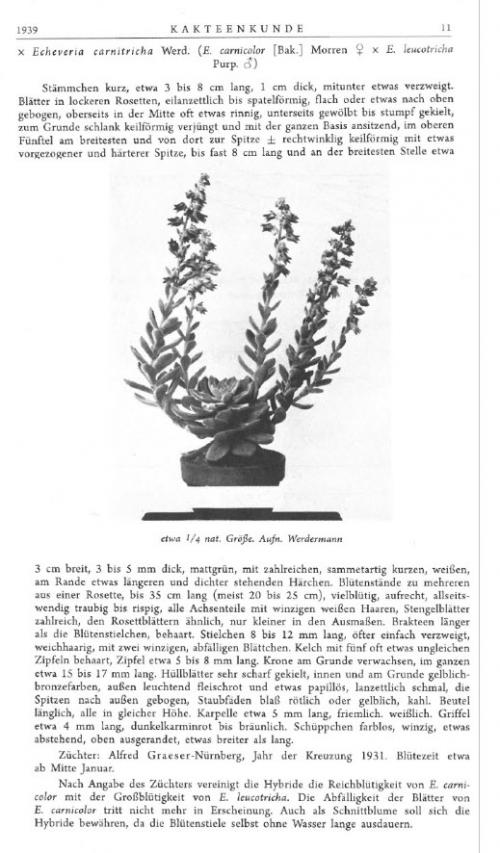Carnitricha ‘카니트리카’
E. carnicolor x E. leucotricha / E. 카니컬러 x E. 레우코트리카
Created by Alfred Gräser, Nürnberg, Germany.

First Descrition by E. Werdermann in Kakteenkunde, 1939.
English translation :
x Echeveria carnitricha Werd. (E. carnicolor (Bak.) Morren x E. leucotricha Purp.)
Stem short, 3 – 8 cm long, 1 cm in diameter, sometimes branched. Leaves in loose rosettes, ovate lanceolate to spatulate, flat or slightly convex, upper side in the middle often slightly channelled, underside convex to bluntly keeled, narrowing cuneate towards base, base united with stem, broadest in upper fifth, apex cuneate with muco, up to 8cm long and up to 3 cm wide, 3 -5 mm thick, dull green, densely hairy, hairs at margins somewhat longer and even more dense. Inflorescences: several from one rosette, 20 – 25 – 35 cm long, erect, raceme with numerous flowers, in all parts hairy. Lower bracts numerous, similar to leaves but smaller. Upper bracts longer than pedicels, hairy. Pedicels 8 -12 mm long, often two branches, hairy, with two tiny leaves soon falling off. Calyx with 5 often unequal sepals, hairy, sepals 5 – 8mm long. Petals united at base, 15 – 17 mm long, sharply keeled, inside yellow-bronze, outside bright fleshy red and somewhat papillose, narrowly lanceolate, tips outcurved. Stamen faintly reddish or yellowish, bare. Anthers elongated, of equal length. Carpel about 5 mm long, awl-shaped, whitish. Style about 4 mm long, dark carmine red to brownish, stigma colourless, very tiny, somewhat spreading, at top emarginated, a little broader than long.
Originator: Alfred Graeser, Nürnberg, obtained in 1931.
Flower time beginning in January.
(Kakteenkunde, 1939)